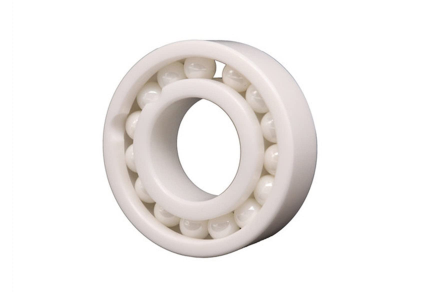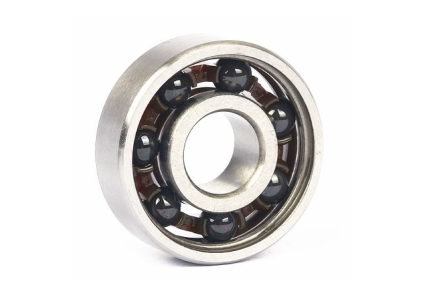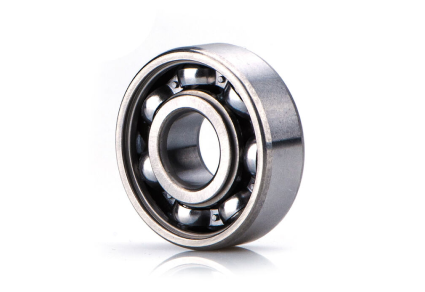Choosing the Right Bearing Material: Full Ceramic, Hybrid Ceramic, Stainless Steel, or Bearing Steel?
Introduction
Bearings quietly ensure everything runs smoothly. But did you know the material they’re made of can make a huge difference?
From full ceramic to hybrid ceramic, stainless steel, and bearing steel, each type has its own superpowers and weaknesses. So, how do you pick the right one? Let’s break it down in a way that’s easy to understand, even if you’re not an engineer!
What Are the Main Bearing Materials?
There are four common types of bearing materials:
Full Ceramic Bearings – Made entirely of ceramic.
Hybrid Ceramic Bearings – A mix of ceramic and metal.
Stainless Steel Bearings – Tough and rust-resistant.
Bearing Steel Bearings – The classic choice, made of strong steel.
Each one is suited for different jobs, so let’s explore their pros and cons to help you decide.
Full Ceramic Bearings: The Extreme Performers (e.g. 6200 Full ceramic bearing)
Pros:
-
Handles Crazy Temperatures: Whether it’s super hot or freezing cold, full ceramic bearings stay strong. Perfect for aerospace or chemical plants!
-
Resists Rust Like a Champ: Ceramic doesn’t care about acids or harsh chemicals—it won’t corrode.
-
Light as a Feather: Ceramic is lighter than metal, which means less weight and better energy efficiency.
-
Super Hard and Durable: Ceramic is way harder than metal, so it wears out much slower.
-
No Magnetism, No Electricity: Great for places where magnets or electricity could cause problems.

full-ceramic-bearing
Cons:
-
Tricky to Make: Ceramic is hard and brittle, making it tough (and expensive) to shape.
-
Pricey: Special materials and complex production mean a higher price tag.
-
Fragile: Ceramic can crack if you drop it or hit it too hard.
Best For: Extreme environments where temperature, corrosion, or magnetism are issues.
Hybrid Ceramic Bearings: The Best of Both Worlds (e.g. 608 skate bearing hybrid ceramic ball bearing)
Pros:
-
High Performance: Combines ceramic’s lightness and low friction with metal’s strength—perfect for speed and less heat.
-
Long Life: Lasts 3-5 times longer than regular steel bearings, meaning fewer repairs.
-
Flexible Design: Designers can tweak settings without worrying too much about side effects.
-
Versatile: Great for high-speed, high-precision, or long-lasting needs.

Cons:
-
Still Costly: Cheaper than full ceramic but pricier than plain steel.
-
Careful Installation: Needs precise setup to avoid damage from shocks or vibrations.
Best For: When you need speed, precision, and durability but can’t go full ceramic.
Bearings: The Rust-Proof Warriors (e.g. SS63 series stainless steel deep groove ball bearings)
Pros:
-
Corrosion Fighter: Perfect for damp or corrosive places—no rust here!
-
Heat Tolerant: Works well in hot conditions without breaking a sweat.
-
Easy to Clean: Ideal for food, pharma, or medical equipment.
-
Low Wear: Stays smooth and lasts longer.

Cons:
-
Expensive: Costs more due to complex production.
-
Not for Heavy Loads: Can’t handle extreme weight as well as others.
-
Magnetic: Might not work where magnets are a no-go.
Best For: Wet, hot, or clean environments where rust is the enemy.
Bearing Steel Bearings: The Classic Choice
Pros:
-
Super Hard: Great for resisting wear and tear.
-
Easy to Make: Simple production means lower costs.
-
Widely Used: Fits most everyday machines.

Cons:
-
Needs Lots of Lube: In tough conditions, it demands good lubrication.
-
Not Great with Heat or Corrosion: Rusts easier and can’t handle extreme temperatures.
-
Shorter Life: Wears out faster under heavy loads or high speeds.
Best For: Budget-friendly options where conditions aren’t too extreme.
How to Choose the Right Bearing Material
Picking the perfect bearing material isn’t rocket science—it’s about matching the job to the material’s strengths. Here’s a quick guide:
-
Full Ceramic: Go for this if you’re dealing with extreme heat, cold, or chemicals. It’s pricey but tough.
-
Hybrid Ceramic: Choose this for high-speed or precision tasks when full ceramic is overkill.
-
Stainless Steel: Perfect for wet or hot environments where rust could ruin everything.
-
Bearing Steel: The go-to for most jobs—affordable and reliable for everyday use.
Pro Tip: Think about your budget, the environment, and how much stress the bearing will face. Need something that lasts forever in a tough spot? Full ceramic might be worth the splurge. Just need something basic? Bearing steel has your back.
Final Thoughts: Which Bearing Material Is Right for You?
Bearings might seem small, but choosing the right material can make or break your machine’s performance. Whether it’s the heat-defying full ceramic, the balanced hybrid, the rust-proof stainless steel, or the classic bearing steel, each has its place. So, next time you’re picking a bearing, ask yourself: What’s the toughest challenge my machine will face? Let that guide you to the perfect choice.
What do you think? Have you ever had to choose between these materials? Share your experience in the comments—we’d love to hear from you!
